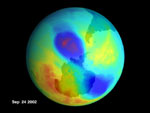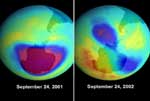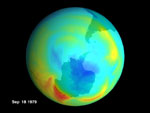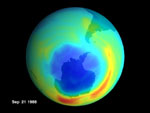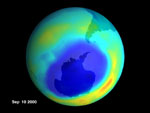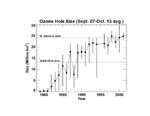September 30, 2002 - (date of web publication)
UNUSUALLY SMALL ANTARCTIC OZONE HOLE THIS YEAR ATTRIBUTED TO EXCEPTIONALLY STRONG STRATOSPHERIC WEATHER SYSTEMS
Image 1
Click here for an animation of the hole's progression. (17 MB animation)
Click here for print resolution of Image 1 (5 MB)
Scientists from NASA and the Commerce Department's National Oceanic and Atmospheric Administration (NOAA) have confirmed the ozone hole over the Antarctic this September is not only much smaller than it was in 2000 and 2001, but has split into two separate "holes."
The researchers stressed the smaller hole is due to this year's peculiar stratospheric weather patterns and that a single year's unusual pattern does not make a long-term trend. Moreover, they said, the data are not conclusive that the ozone layer is recovering.
Image 2
Paul Newman, a lead ozone researcher at NASA's Goddard Space Flight Center, Greenbelt, Md., said this year, warmer-than-normal temperatures around the edge of the polar vortex that forms annually in the stratosphere over Antarctica are responsible for the smaller ozone loss.
Estimates for the last two weeks of the size of the Antarctic Ozone Hole (the region with total column ozone below 220 Dobson Units), from the NASA Earth Probe Total Ozone Mapping Spectrometer (EPTOMS) and the NOAA-16 Solar Backscatter Ultraviolet instrument (SBUV/2), are around 15 million square kilometers (6 million square miles). These values are well below the more-than 24 million sq. km. (9 million sq. mi.) seen the last six years for the same time of year.
Images 3 through 5:
September 18, 1979
September 21, 1988
September 10, 2000
The stratosphere is a portion of the atmosphere about 6-to-30 miles above the Earth's surface where the ozone layer is found. The ozone layer prevents the sun's harmful ultraviolet radiation from reaching the Earth's surface. Ultraviolet radiation is a primary cause of skin cancer. Without protective upper-level ozone, there would be no life on Earth.
"The Southern Hemisphere's stratosphere was unusually disturbed this year," said Craig Long, meteorologist at NOAA's Climate Prediction Center (CPC). The unusual weather patterns were so strong, the ozone hole split into two pieces during late September. NOAA's CPC has been monitoring and studying the ozone since the early 1970s. "This is the first time we've seen the polar vortex split in September," said Long.
At South Pole Station, balloon-borne ozone-measuring instruments launched by NOAA's Climate Monitoring and Diagnostics Laboratory (CMDL) reveal the vertical structure of the developing ozone hole. Bryan Johnson, a scientist with CMDL, said the main ozone depletion region, from 7-to-14 miles above the Earth, has large ozone losses, similar to the last few years. At more than 15 miles above the Earth, surface measurements show higher-than-normal ozone concentrations and higher temperatures.
Image 6 Click on image for animation- 2.2 MB animation
The combination of these layers indicate total ozone levels in a column of atmosphere will be higher than observed during the last few years, Johnson said. However, some layers may still show complete ozone destruction by early October, when ozone depletion is greatest.
In 2001, the Antarctic ozone hole was larger than the combined area of the United States, Canada and Mexico. The last time the ozone hole was this small was in 1988, and that was also due to warm atmospheric temperatures.
"While chlorine and bromine chemicals cause the ozone hole, temperature is also a key factor in ozone loss," Newman said. The Montreal Protocol and its amendments banned chlorine-containing chlorofluorocarbons (CFCs) and bromine-containing halons in 1995, because of their destructive effect on the ozone layer. However, CFCs and halons are extremely long-lived and still linger at high concentrations in the atmosphere.
Image 7
The coldest temperatures over the South Pole typically occur in August and September. Thin clouds form in these cold conditions, and chemical reactions on the cloud particles help chlorine and bromine gases to rapidly destroy ozone. By early October, temperatures usually begin to warm, and thereafter the ozone layer starts to recover.
NOAA and NASA continuously observe Antarctic ozone with a combination of ground, balloon, and satellite-based instruments.
Caption for Image and Animation 1: 2002 ANTARCTIC OZONE HOLE
Click here for print resolution of Image 1 (5 MB)
On September 24, 2002, the Antarctic ozone hole split into
two holes for the first time since satellite measurements have been taken. Dark
blue indicates the hole, an area with at least 20% less ozone than normal.
Animation (17 MB): Progression of the Antarctic ozone hole, August 15-September 29, 2002. The maximum size occurred September 19, while the minimum value of ozone was recorded September 9. CREDIT: NASA Goddard Space Flight Center Scientific Visualization Studio.
Caption for Image 2: OZONE COMPARISON
Comparison of the first split ozone hole on record (right, 2002) and the Antarctic ozone
hole at the same time one year earlier (left, 2001). The hole is dark blue and
magenta. In 2001, the ozone layer thinning over Antarctica reached 26.5 million
square kilometers, larger than the size of the entire North American continent.
Due to higher Antarctic winter temperatures, the 2002 'hole' seems to be about
40% smaller.
Caption for Images 3-5: ANTARCTIC OZONE HOLE MAXIMUM AREAS
Click here for print resolution of Image 3 (5 MB)
Click here for print resolution of Image 4 (5 MB)
Click here for print resolution of Image 5 (5 MB)
High resolution
images of the maxima for 1979 through 2003 (except 1995)
Antarctic
ozone hole maximum sizes for 1979 (September 18), 1988 (September 21), and 2000
(September 10). 1979 was the first year NASA collected satellite data on ozone
levels. The 2002 hole is the smallest since 1988, pictured here, when chlorine
and bromine from human-produced compounds started to contribute to large annual
losses of ozone. In September 2000, the Antarctic ozone hole briefly approached
30 million square kilometers, the largest on record, larger than the entire North
American continent. CREDIT: NASA Goddard Space Flight Center Scientific Visualization
Studio.
Caption for Image 6: YEARLY ANTARCTIC OZONE HOLE MAXIMA (2.2 MB animation)
Yearly maximum area of the Antarctic ozone hole from 1979 to 2001. Data from NASA EP-TOMS. CREDIT: NASA Goddard Space Flight Center Scientific Visualization Studio.
Caption for Image 7: GRAPHING THE SIZE OF THE OZONE HOLE 1980-2001
The graph above represents the size of the Antarctic ozone hole from 1980 to 2001 during the months when the greatest amount of ozone is depleted. NASA researchers confirmed that this September 2002, the ozone hole over the Antarctic is much smaller than it was in 2000, but stressed that it's due to peculiar stratospheric weather patterns, and is not an indication that the ozone layer is recovering.
In 2001, the Antarctic ozone hole reached a maximum size of over 26 million kilometers (km) squared (10 million square miles), larger than the entire area of North America including the U.S., Canada and Mexico combined. In the year 2000, it briefly approached 30 million km squared (11.5 million square miles). The last time the ozone hole was as small as it is this year was 1988, and that was also due to warm temperatures. CREDIT: NASA
To view stills and movies from 1979 to present covering both the Antarctic and Arctic ozone levels, click here.
For more information contact:
Elvia Thompson
Headquarters, Washington
(Phone: 202/358-1696)
Robert J. Gutro/Cynthia M. O'Carroll
Goddard Space Flight Center, Greenbelt, Md.
(Phone: 301/286-4044 / 614-5563)
Carmeyia Gillis
National Oceanic and Atmospheric Administration/NOAA Climate Prediction Center
(Phone: 301/763-8000, ext. 7163)
Scientific Visualization Studio
National Oceanic and Atmospheric Administration
Total Ozone Mapping Spectrometer
Climate Prediction Center
Climate Monitoring and Diagnostics Laboratory
Ozone Hole Monitoring
Stratospheric Ozone online class resources
NASA Ozone Fact Sheet
Previous NASA TV Stories:
2001 Antarctic ozone hole
2000 - Largest ozone hole on record
